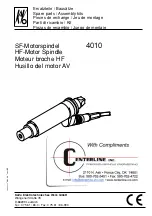
3
31. Don’t use in dangerous environment. Don’t use
power tools in damp or wet location, or expose
them to rain. Don’t use this buffer in a flammable
environment. Keep work area well lighted.
32. Keep work area clean. Cluttered areas and
benches invite accidents.
33. Use the right tool. Don't force tool or attachment to
do a job for which it was not designed.
34. Use proper extension cord. Make sure your
extension cord is in good condition. When using
an extension cord, be sure to use one heavy
enough to carry the current your product will draw.
An undersized cord will cause a drop in line
voltage resulting in loss of power and overheating.
Table 1
(see sect. 7.2)
shows the correct size to
use depending on cord length and nameplate
ampere rating. If in doubt, use the next heavier
gage. The smaller the gage number, the heavier
the cord.
35. Maintain tools with care. Keep tools sharp and
clean for best and safest performance. Follow
instructions for lubricating and changing
accessories.
36. Only apply workpiece to lower half of buffing
wheel.
37. Do not overtighten wheel nut.
38. Use buffing wheel suitable for speed of machine.
39. Do not crowd the work so that the wheels slow.
40. Use only the flanges that are furnished with the
buffer.
41. Do not start the buffer while a workpiece is
contacting a buffing wheel.
Familiarize yourself with the following safety notices used in this manual:
This means that if precautions are not heeded, it may result in minor injury and/or possible
machine damage.
This means that if precautions are not heeded, it may result in serious, or possibly even fatal,
injury.




































